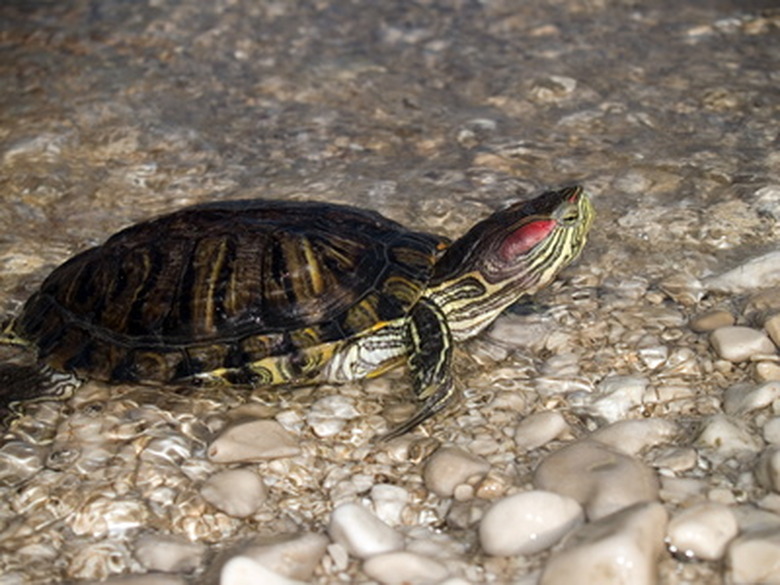How Turtles Grow & Live
Different species of turtles are found around the world, on land, in lakes and rivers, and in oceans. They first evolved 200 million years ago and their distinctive shell makes them easy to identify. Turtle shells are made up of broadened bones that enclose the soft body of the turtle and help keep it safe from predators. The life cycle of a turtle starts with it hatching from an egg, followed by rapid growth, maturity, sexual reproduction and a long life span.
Because turtles are cold-blooded reptiles, they take on the temperature of their surroundings and hibernate in cold climates. Some turtles are herbivorous, some eat both plants and animals and others are carnivorous while, for some, the young have a different diet than the adults. Overall, the way they grow and live is varied but they do share several common elements.
TL;DR (Too Long; Didn't Read)
**TL;DR (Too Long; Didn't Read)**
Turtles evolved about 200 million years ago and the different turtle species have several characteristics in common. They are all cold-blooded and lay eggs with tough, leathery shells in primitive nests such as sand pits. Turtles all have long lives but many species are endangered because of hunting and a loss of habitat.
Turtle Reproduction and Young Turtles
Turtle Reproduction and Young Turtles
Male and female turtles mate to fertilize the eggs in the female but turtles don't have a sex gene, so the sex of the young is not determined at fertilization. Instead, the female turtle lays the fertilized eggs in a location where the young can reach safety and feed when they hatch. For land-based and freshwater turtles this may be in a stump, a depression in the ground or in a swampy area. Sea turtles crawl out on a beach and dig a shallow pit before laying the eggs in it and burying them. The sea turtle size of some species makes this a difficult chore, as they weigh up to 1500 pounds and have to move up the beach on their flippers. None of the turtle species care for their young, and they generally never see their parents.
The eggs take two to three months to hatch and the temperature of the eggs during the middle period determines the sex of the young. Lower temperatures yield mainly male turtles while higher temperatures result in mostly female hatchlings. The temperature difference that changes the sex of the young turtles can be as little as two to three degrees Celsius. As soon as they hatch, the young turtles have to scramble to safety and start feeding. Sea turtle young that have just hatched are especially at risk. They have to reach the sea before hovering sea birds that are on the look-out for a young sea turtle outline on the sand can swoop in and eat them. Up to 80 eggs may hatch at a time but few of the young turtles live to reach maturity.
The Characteristics and Life Cycle of a Turtle
The Characteristics and Life Cycle of a Turtle
The most distinctive common characteristic of turtles is their shell. The shell is made up of flattened ribs and vertebrae as well as parts of the pelvis. The domed upper part and the flat lower shell consist of plates that grow continuously during the life of the turtle. Land-based and freshwater turtles can withdraw into their shells for protection but sea turtles have a smaller, more leathery shell and can't withdraw their flippers and heads.
After hatching from an egg, a turtle has to make sure it isn't eaten by a predator before its shell hardens and it has more protection. The young turtles grow quickly until they reach sexual maturity and then grow more slowly. Each growth year adds a ring on the turtle's shell so it's easy to tell how fast they have grown and how old they are. Once they are fully grown, they have fewer predators and can reach ages of over 100 years. Although they have fewer natural predators, many turtle species are endangered because they were hunted and because they are losing their habitats. Swamps are drained, rivers become polluted and the plastic in the oceans kills the turtles that eat it because it looks like food.
Cite This Article
MLA
Markgraf, Bert. "How Turtles Grow & Live" sciencing.com, https://www.sciencing.com/turtles-grow-live-6974785/. 22 November 2019.
APA
Markgraf, Bert. (2019, November 22). How Turtles Grow & Live. sciencing.com. Retrieved from https://www.sciencing.com/turtles-grow-live-6974785/
Chicago
Markgraf, Bert. How Turtles Grow & Live last modified March 24, 2022. https://www.sciencing.com/turtles-grow-live-6974785/
